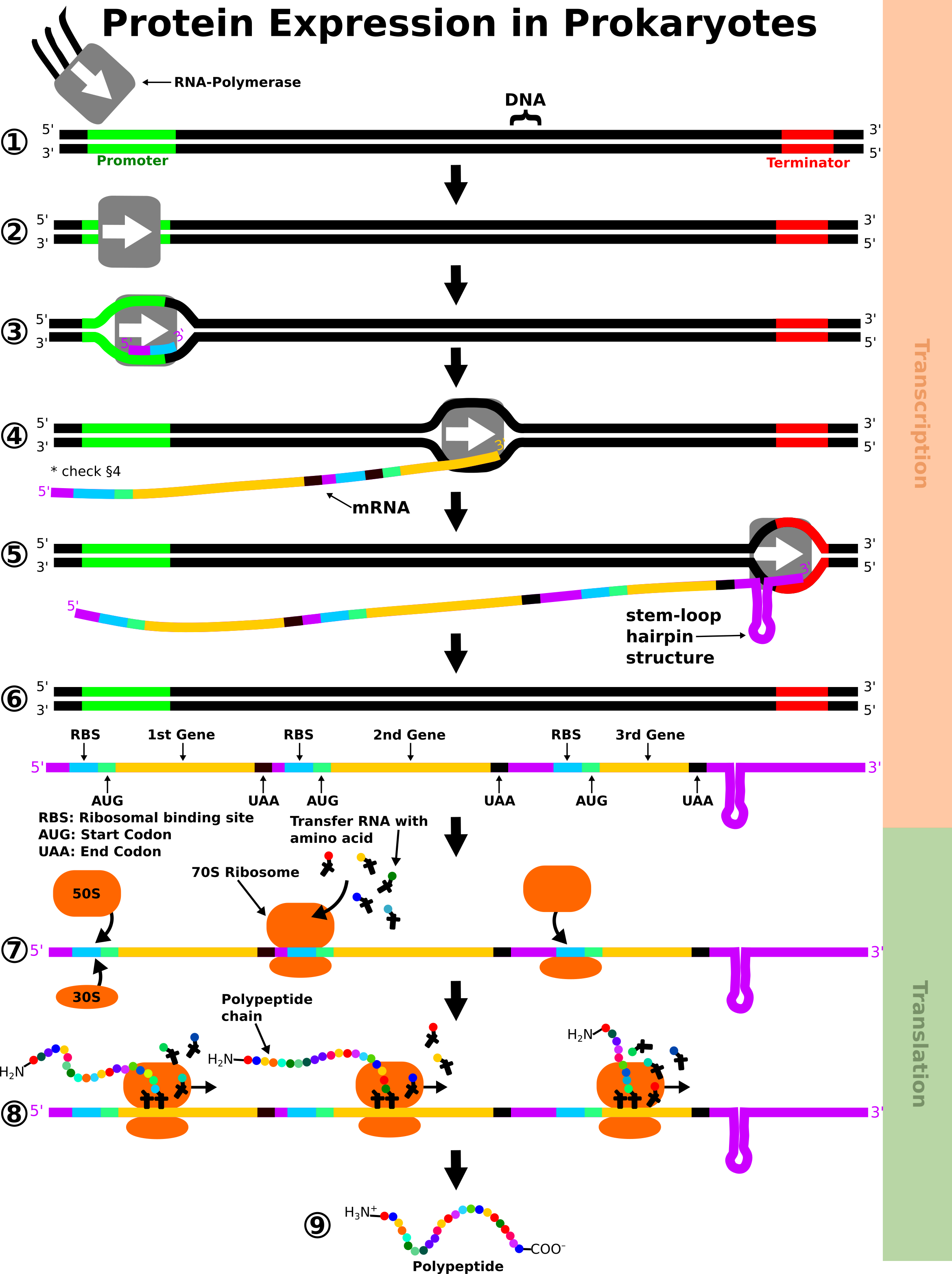DNA Replication, Translation and Transcription
DNA Replication

In .pdf format:

Download the summary of DNA transcription and translation in eukaryotes as .pdf format. Click here to download.
Protein Expression in Eukaryotes

Transcription
1.) RNA – Polymerase attaches to the promoter. The promoter is a region on the DNA, which is located upstream, near the transcription start side.
2.) Transcription is initiated.
3.) The RNA-Polymerase is starting to synthesize the Pre-mRNA from the 5’ to the 3’ direction.
4.) The RNA-Polymerase continues to synthesize the pre-mRNA. The 5’ end of the pre-mRNA receives a 5’ Cap. The 5’ Cap is usually a modified guanine molecule. The 5’ Cap increases the stability of the pre-mRNA and the mRNA.
5.) The terminator region of the DNA codes a poly(A) sequence, thus the pre-mRNA receives at its 3’ end a poly(A)-tail. The poly(A) tail stabilizes the mRNA from degradation in the cytoplasm. The poly(A) tail also helps to transport the mRNA from the nucleus to the cytoplasm.
Modification
6.) The transcription is finished, and the pre-mRNA is ready to be spliced. Note: All pre-mRNA modifications happen inside the nucleus.
7.)The pre-mRNA gets spliced, where introns get removed. Note: As described in the scheme, the exons are combined together. They can be combined in a different order, such as 1-2-3-4-5 or 1-3-5 or 2-4, but not 1-5-3-4 (A higher integer number cannot lay in between two smaller numbers).
Translation
8.) The 40S and 60S ribosomal subunits are mediated to the mRNA by its 5’ Cap. The 40S ribosomal subunit attaches first to the mRNA. Subsequently the 60S ribosomal subunit binds to the 40S ribosomal subunit on the mRNA to form the functional ribosome.
9.) Once the ribosome is assembled, the translation of the mRNA is initiated from a start codon on the mRNA. tRNA’s charged with amino acids enter the ribosomes, where their amino acid is transferred on to the growing polypeptide chain. Once the tRNA donated its amino acid, it exits the ribosome. Note: The polypeptide chain is being built from N-terminus (–NH3+) to C-terminus (–COO–).
10.) The built polypeptide chain is now ready to be folded into the destined protein.
In .pdf format:
You need to print this .pdf dokument at 100% zoom to obtain the proper size.
Protein Expression in Prokaryotes

Transcription
1.) RNA – Polymerase attaches to the promoter. The promoter is a region on the DNA, which is located upstream, near the transcription start side.
2.) Transcription is initiated.
3.) The RNA-Polymerase is starting to synthesize the mRNA from the 5’ to the 3’ direction.
4.) The RNA-Polymerase continues to synthesize the mRNA. (Note: Unlike as in eukaryotic mRNA, the prokaryotic mRNA does not receive a 5’ cap)
5.) The terminator region of the DNA codes a palindromic sequence. This sequence causes the mRNA to form a stem-loop hairpin structure. This hairpin structure leads to the dissociation of the RNA-Polymerase from the DNA.
6.) The transcription is finished, and the mRNA is ready to be translated. One translated mRNA can contain more than one gene, which encodes a protein. Thus more than one protein can be encoded on one mRNA. Note: Prokaryotic cells do not have a nucleus. Unlike in Eukaryotic cells, the mRNA does not need to be modified by splicing. Thus, the mRNA in Prokaryotic cells is ready to be translated immediately after transcription.
Translation
7.) The 50S and 30S ribosome subunits are assembled together to form the whole ribosome complex (70S).
8.) Once the ribosome is assembled, the translation of the mRNA is initiated from a start codon (AUG) on the mRNA. tRNA’s charged with amino acids enter the ribosomes, where their amino acid is transferred on to the growing polypeptide chain. Once the tRNA donated its amino acid, it exits the ribosome. Note: The polypeptide chain is being built from N-terminus (–NH3+) to C-terminus (–COO–).
In .pdf format:

